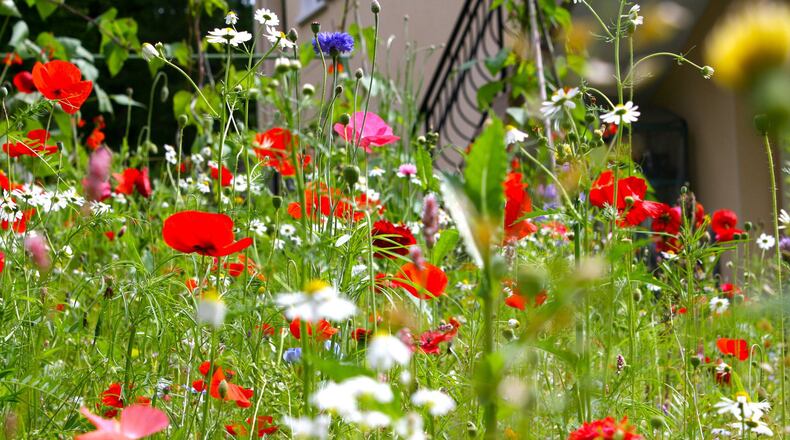Whenever you disturb a lot of ground, there’s an opportunity to sow wildflowers for beauty and erosion control. Flowers such as the red European corn poppy made the battlefields bloom bright red after the World War I armistice to germinate in a single massive display. The ground, pocked with excavated trenches, bomb craters and vehicle tracks allowed so much dormant seed to sprout that it became a symbol of veteran sacrifice. When your yard or property is torn up for any reason, that’s the ideal time to sow not just for a spring flower show, but to help stabilize the soil against erosion by rain and runoff.
When you’re working with larger sites or sowing a former lawn, the smaller wildflower packets at the garden center aren’t enough to make a difference. You’ll need to order by the pound to ensure the distribution rate is enough to create a really big, diverse stand that remains in flower from the earliest spring to the end of summer. Some may be perennial or biennial and become naturalized while others that are more ephemeral won’t appear the second year unless conditions are suitable for reproduction.
The goal is to obtain a blend of wildflowers suited to your immediate climate for the best chance of having them survive and naturalize after the first big season. This requires an accomplished seed house focusing on wildflowers, particularly when seeking natives for the best local fit. A number of excellent American seed houses sell wildflower seed online so you can start shopping today:
— Applewood Seed Co., applewoodseed.com, 303-431-7333
— American Meadows, americanmeadows.com, 877-309-7333
— Western Native Seed, www.westernnativeseed.com, 719-942-3935
Seed stock is divided into individual species or seed mixes which are blended for different climates and outcomes. The great benefit of a mix for first-time users is the ability to discover which wildflowers do best in your yard. Once you know which germinate readily and reach maturity to bloom well, more of these seeds can be sown in the future with confidence they will thrive.
Here are how seed mixes differ and why:
Seed mixes: These mixes include the most widely adapted species found in most states. There is no regional specificity, so if your area lacks summer rainfall, they may not thrive.
Native mixes: These wildflowers are selected by their local nativity and feature many species unique or endemic to certain areas. Western gardeners should lean toward these collections of top native species for desert or mountain or valley, so choose those that match your microclimate best.
Regional mixes: Regional mixes suit a wide climatic range with natives, exotic species and some new varieties to offer the widest range of plant forms and flower colors. In these you’ll find shasta daisy, a non-native hybrid that Luther Burbank bred for the same adaptability as wildflowers.
Climatic mixes: A climate area such as the Pacific Coast can have its own tailored seed mixes that are perfectly adapted to high rainfall, cloudy conditions and cooler temperatures. This is equally important in the desert where heat and extreme drought preclude most species from outside the ecosystem.
Even if you don’t have a larger site for sowing, wildflowers are a great way to spice up modern and dry gardens in the West with vivid spring color. When sown in dry stream beds, the load of early wildflowers is like a miracle at winter’s end, germinating round rocks and boulders where seeds lodge. These otherwise parched places are often the only ones sandy-gravelly enough for many wildflower species. Older gravel fields and rock gardens of succulents and alpines can easily explode into bloom as well. Virtually any patch of roughed up well drained ground in full sun will yield well. These are the sites where efforts to sow with the early rains yield ultimate payoffs of eye-popping color tended by nature herself in the perfect season for flowers.
———
Maureen Gilmer is an author, horticulturist and landscape designer. Learn more at www.MoPlants.com
About the Author
Keep Reading
The Latest
Featured


